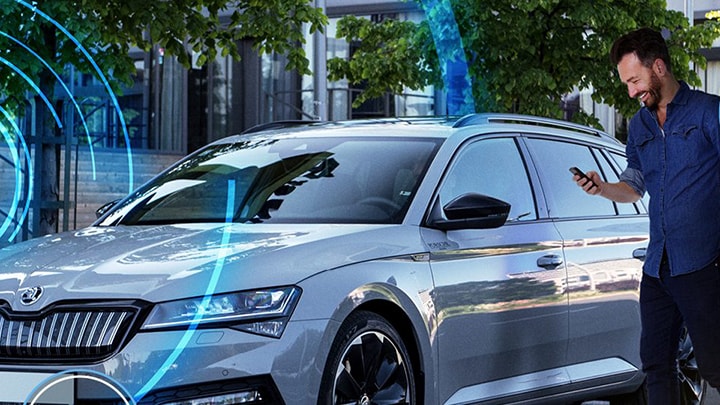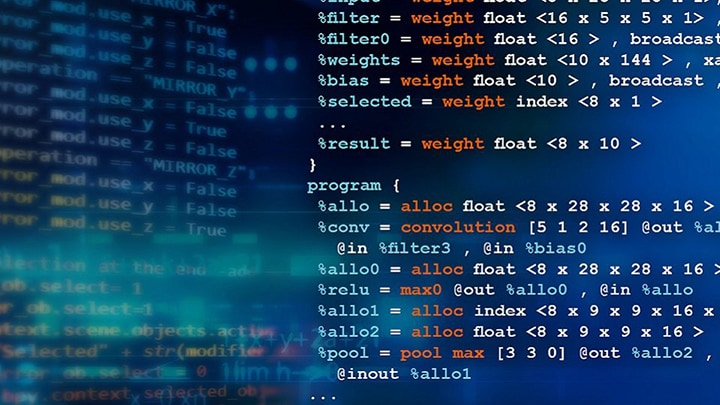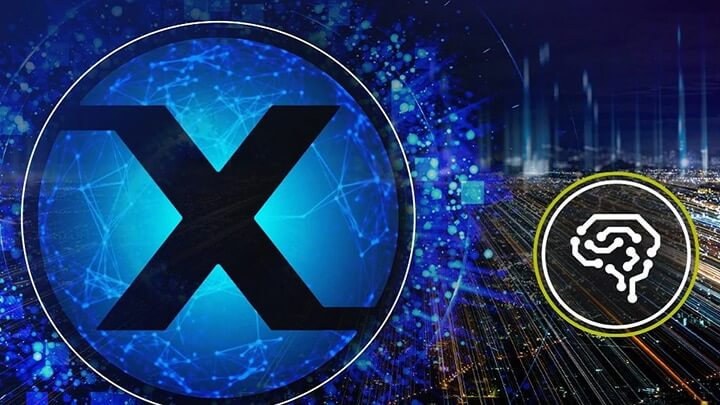If there is one true indicator to measure the disruptiveness of a new
technology, it’s certainly the public outpouring of fear and suspicion.
If we use societal angst as a measure, the current renaissance of
artificial intelligence (AI) is a good candidate for groundbreaking
technological disruption. AI will change life as we know it, as Elon Musk,
Bill Gates, Stephen Hawking and other great minds have told us. The widespread
anxiety about the
harmful consequences of AI applications
is not an unparalleled reaction to technological change but rather an
expression of the societal unease that commonly precedes the changes
associated with new technologies and the vast potential that comes with them.
We’re looking beyond today’s IoT, toward a future where smart
connected devices not only talk with each other but where they use AI to
interact with each other on our behalf. This new global fabric of artificially
intelligent things one day will be known as the AIoT,
the Artificial Intelligence of Things.
When pure mathematics start to make an impact on real life
As a discipline of mathematics – and, to a certain extent, of
philosophy – AI lived in the shadows for more than six decades before
public interest suddenly soared in the present period. One reason for the
current publicity is that, for a long time, considerations on AI applications
were purely theoretical or at least science fiction. For artificial
intelligence use cases to become real in the present IoT environment, three
conditions had to be fulfilled:
- very large real-world data sets
-
a hardware architecture and environment with significant processing
capability
-
the development of new powerful algorithms and artificial neural networks
(ANN) to make best use of the above

It is apparent that the two latter requirements depend on each other, and that
the breakthroughs in deep neural nets could not have occurred without a
significant increase in processing power. As for the input: large data sets of
every quality – vision, audio and environmental data – are being
generated by an increasing number of embedded IoT devices. Today, the flow of
data grows exponentially. In fact, annual data generation is expected to reach
44 zettabytes (one zettabyte is 1 billion terabytes) by 2020, which translates
to a compound annual growth rate (CAGR) of 141 % over 5 years. Just 5 years
after that, it could reach
180 zettabytes.
Starting around 2015, when multicore application processors and graphics
processing units (GPUs) became widely available, we’ve also commanded
the tools to cope with these amounts of data. Parallel processing became a
much faster, cheaper and more powerful business. Add fast, abundant storage
and more powerful algorithms to sort and structure that data, and suddenly
there is an environment in which AI can prosper and thrive.
In 2018, neural network-trained AI voice recognition software is an integral
part of a variety of consumer and industrial applications.
Computing power is increasing by roughly a factor of 10 each year, mainly driven by new classes of custom hardware and processor architecture.
This computing boom is a key component in AI progress and helping to make AI
mainstream in the future. And this is just the beginning.
AI: Objects to reflect human reasoning
By classic definition, artificial intelligence is a rather unspectacular
affair. In his groundbreaking 1976 paper
Artificial Intelligence: A Personal View, British neuroscientist and AI pioneer David Marr states: The goal of
AI is to identify and to solve useful information processing problems and to
give an abstract account of how to solve it, which is called a method.
The small but decisive detail with AI is that the information processing
problems it deals with have their roots in aspects of biological information
processing. In other words: AI looks to re-engineer the structure and function
of the human brain to enable machines to solve problems the way humans would
– just better.
Compared with the scientific effort, today’s industry’s approach
on AI is much more pragmatic. Rather than trying to achieve a replica of the
human mind, current AI development uses human reasoning as a guide to provide
better services or create better products. But how does that work?
Let’s have a look at the current approaches.
ML: Algorithms to parse, learn, determinate or predict
As a subset of artificial intelligence, machine learning uses statistical
techniques to give computers the ability to learn without being explicitly
programmed. In its most crude approach, machine learning uses algorithms to
analyze data and then makes a prediction based on its interpretation. To
achieve this, machine learning applies pattern recognition and computational
learning theory, including probabilistic techniques, Kernel methods and
Bayesian probabilities, which have grown from a specialist niche to become mainstream in current ML
approaches. ML algorithms operate by building a
model
from an example
training set
of input in order to make data-driven predictions expressed as outputs.
Computer vision is the most active and popular application field where ML is
applied. It is the extraction of
high-dimensional
data from the real world to produce numerical or symbolic information –
ultimately in the forms of decisions. However, until very recently, an
extensive portion of hand coding was involved for machines to develop advanced
pattern recognition skills. Human operators had to extract edges to define
where an object begins and where it ends, apply noise removing filters or add
geometrical information, e.g., on the depth of a given object. It turned out
that even with advanced machine learning training software, it’s not a
trivial task for a machine to make real sense of a digital reproduction of its
environment. This is where deep learning comes into play.
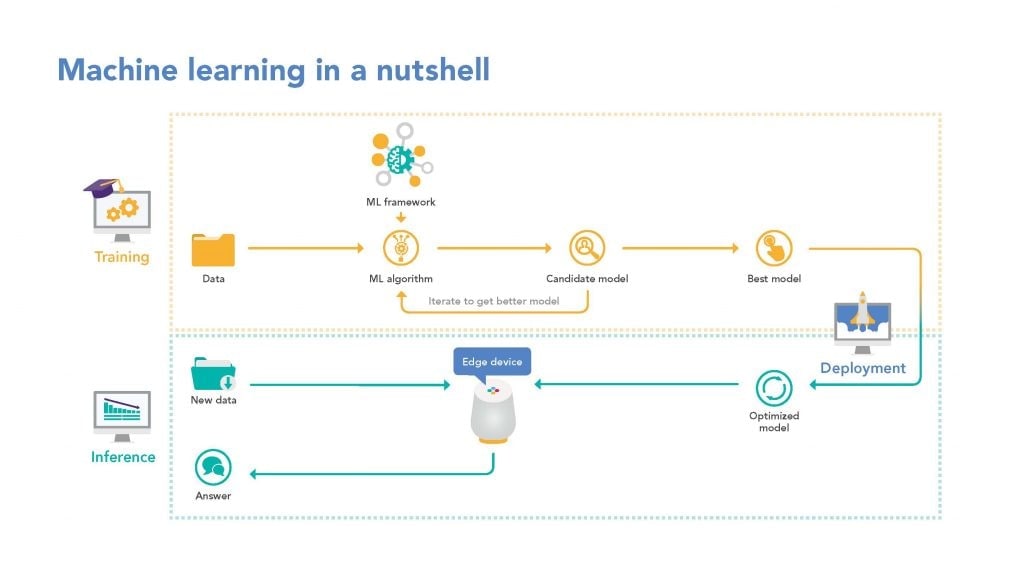
DL: Mirroring of the human neuronal network
It’s a decades’ old idea that software can simulate a biological
neocortex’s array of neurons in an artificial “neural
network”. Deep learning algorithms attempt exactly that – to
mimic the multilayer structure and functionality of the human neuronal
network. In a real sense, a deep learning algorithm learns to recognize
patterns in digital representations of sounds, images and other data. But how?
With the current improvements in algorithms and increasing processing
capacity, we can now model more layers of virtual neurons than ever before,
and thus run models in much greater depth and complexity. Today, Bayesian deep
learning is used in multilayer neural nets to tackle complex learning
problems.
However, what we can do today still mostly falls into the concept of
“narrow” or “weak” AI
– technologies able to perform specific tasks as well as, or better
than, humans can. For instance, AI technologies for image classification or
face recognition perform certain facets of human intelligence, yet not the
full spectrum or even a combination of several human capabilities. A machine
capable of performing a multitude of complex tasks, one that exhibits behavior
at least as skillful and flexible as a human being, would be considered
“strong AI”. While the experts are divided over the question
whether strong AI can ever be achieved, it doesn’t stop them from
trying.
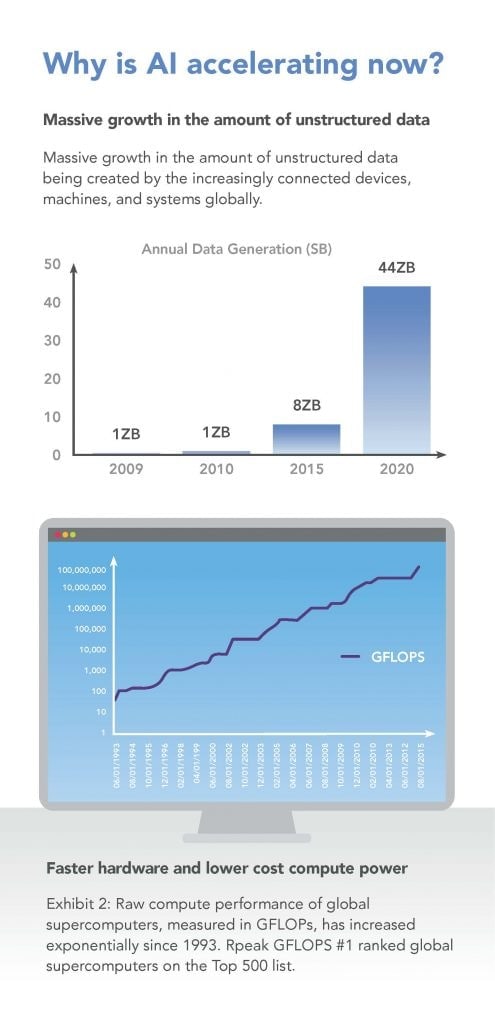 Since 2013, the external investment growth in artificial intelligence has
tripled
Since 2013, the external investment growth in artificial intelligence has
tripled
One solid indicator for the disruptive potential of the technology is the
dimension of investment. According to McKinsey,
$26 to 39 billion
were invested in AI in 2016, most of it by tech giants such as Google™
and Baidu™. Being one of the most well-funded categories, Startups in
the space
increased about 141 %. Recognizing the industry’s enormous potential, governments around
the globe aim to put themselves in the top positions of AI. While a notable
amount of national AI plans are in creation, the greatest economic gains are
expected for China (26 % boost to GDP in 2030) and North America (14.5 %
boost), accounting for almost 70 % of the global impact.
According to recent studies, Artificial Intelligence has the potential to
almost double the value of the digital economy to
US$ 23 trillion by 2025. From a strategic viewpoint, AI’s biggest potential is seen in its
complementary nature to the IoT. An integrated technology portfolio creates a
powerful new platform for digital business value.
Advancing AI to the Edge I:
High Performance Processing to do the Job
As we have seen, for AI to unfold its massive potential relies heavily on
adequate hardware. Machine learning, in particular, requires enormous
processing and storage capacity. A training cycle for one of
Baidu’s speech recognition models
for instance, requires not only four terabytes of training data, but also 20
exaflops of compute — that’s equivalent to 20,000 quadrillion
math operations per second — across the entire training cycle. Given
its hunger for powerful hardware, it is no wonder that AI today is still
mostly confined to data centers.
Uncoupling AI from the data centers and advancing it to the endpoints of the
IoT will allow us to tap its full potential. Edge processing has taken the
control of computing applications, data and services away from some central
nodes (the “core”) to the periphery of the Internet. Processing
this data at the edge, significantly decreases data volumes to be moved,
thereby increasing privacy, reducing latency and improving
quality of service.
No longer relying on a central core also means the removal of a major
bottleneck and potential single point of failure. Edge processing is based on
distributed resources that may not be continuously connected to a network in
such applications as autonomous vehicles, implanted medical devices, fields of
highly distributed sensors and a variety of mobile devices. To make use of AI
in this challenging environment, an agile application that can retain learning
and apply it quickly to new data is necessary. This capability is called
inference: taking smaller chunks of real-world data and processing it
according to training the program has done.
For inference to work in edge environments, processing architecture and
hardware are required that are optimized and come with certain requirements on
processing capacity, energy efficiency, security and connectivity. NXP has
established leadership in machine learning at the edge – particularly
for the inferencing tasks. The NXP portfolio covers almost the entire MCU
and application processors portfolio that is used in modern AI applications:
i.MX 6, 7 and 8 product families, Kinetis MCUs and Low Power Cortex,
QorIQ® communications processor portfolio
and S32 MCUs and Microprocessor Units. In fact, we have been ranked as one of
the world’s top three artificial intelligence chipset companies.
Advancing AI to the Edge II: Dedicated Machine Learning Environment
To build innovative AI applications with cutting-edge capabilities, developers
depend on a machine learning software environment that enables easy
integration of dedicated functionalities into consumer electronics, industrial
environments, vehicles and other embedded applications, in general. But to
roll out AI-based business models at a much broader scale and to make AI
applications available to billions of end users across all verticals, the
industry must first overcome past limitations.
This is why NXP has developed machine learning hardware and software, which
enables inference algorithms to run within the existing architecture. The NXP
ML environment enables fast-growing machine learning use-cases in vision,
voice, path-planning and anomaly detections and the integration of platforms
and tools for deploying machine learning models, including neural networks and
classical machine learning algorithms, on those engines.
And this is only the first step, as NXP is already working to integrate
scalable artificial intelligence accelerators in its devices that will boost
machine learning performance by at least an order of magnitude.
A Glimpse into the future: Artifical Intelligence of Things
By designing things with smart properties and connecting them into the
Internet of Things, we have created a global web of assets that have enhanced
our lives and made them easier and more secure. The IoT gave us eyes and ears,
and even hands, to reach out from the edge of the network into the physical
reality where we gather raw information, which we stream to the cloud, where
it’s processed into something of superior value: applicable knowledge.
By adding high-performance processing, we’ve started to process and
analyze information less often in data centers and the cloud, and more now at
the edge, where we see the magic occur. We witness that magic in smart traffic
infrastructure, in smart supply chain factories, on mobile devices, in
front-end stores and in real time, where all the action takes place that makes
our lives colorful.
The IoT in its present shape has equipped us with unprecedented opportunities
to enrich our lives. Yet, it is only a stopover on the way to something even
bigger and more impactful. We are talking about the artificial intelligence of
things.
Today’s smart objects, even though they stream data, learn our
preferences and can be controlled via apps, they are not AI devices. They
‘talk’ to each other, yet they don’t play together. A
smart container that monitors the cold chain of a supply of vaccines is not an
AI system unless it does ‘something’, such as making a
prediction about the temperature development in the container and
automatically adjusts the cooling.
An autonomous car or a search-and-rescue drone that autonomously navigates
off-shore is in fact an AI system. If it drives or flies on behalf of you, you
can trust that some serious AI capabilities are involved. Reading, speaking or
translating language, predicting the mass and speed of an object, buying stock
on your behalf, recognizing faces or diagnosing breast cancer, are all
artificially intelligent characteristics when done by an algorithm.
Now, imagine a world in which the
entirety of AI things was connected. Expanding the edge of the IoT with cognitive functions such as learning,
problem-solving and decision-making would turn today’s smart things
from mere practical tools into true extensions of ourselves, multiplying our
possibilities to interact with the physical world.
As an integral part of the IoT, artificial intelligence is the foundation for
entirely new use cases and services. Siemens®, for example, is using AI
to improve the operation of gas turbines. By learning from operating data, the
system can significantly reduce the emission of toxic nitrogen oxides while
increasing the performance and service life of the turbine. Siemens
is also using AI systems to autonomously adjust the blade angle of downstream
wind turbines to increase the plant’s yield.
GE’s drone and robot-based industrial inspection service,
Rolls-Royce® IoT-enabled airplane engine maintenance service and
Duplex’s AI voice
are other examples to prove the move towards the AI of things.
Now, what does this mean for the future?
The truth is, even with a broad range of nascent AIoT applications emerging,
we can’t even fathom what else is coming. One thing is for sure, though
– today’s digital age society is undergoing a fundamental
change. The paradigm shift that comes with the convergence of AI and the IoT,
will be even greater than the one we have witnessed with the introduction of
the personal computer or the mobile phone. NXP is driving this transformation
with secure, connected processing solutions at the edge, enabling a boundless
multitude of applications in the future AIoT.
Continue reading part II of this blog series under
this link
to learn about AI implications for IoT Security.




 Since 2013, the external investment growth in artificial intelligence has
Since 2013, the external investment growth in artificial intelligence has
